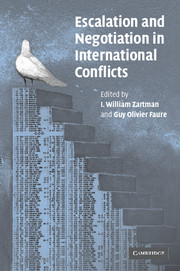Formal Models of Crisis Bargaining
Over the last quarter century, crisis bargaining has become the prevailing paradigm for the study of war. This textbook presents a concise and approachable overview of the crisis bargaining literature, surveying the canonical formal models in the bargaining approach to war. It begins by considering different explanations for war, then delves into two classes of explanation: commitment problems and incomplete information. This textbook is essential reading for advanced undergraduates, graduates, and researchers alike. Each chapter delves into a specific part of the puzzle, rigorously unravelling the twisted logic that causes wars to begin. More than seventy illuminating figures illustrate the strategic reasoning outlined and more than 100 exercises of graded levels of difficulty help clarify readers' own understanding of the issues. Online resources include an instructor answer key and numerous engaging video lectures.
- Provides a concise and intelligible overview of crisis bargaining for undergraduates
- An essential reference resource and learning tool for graduates wishing to publish their own original research
- Each chapter delves into a specific part of the puzzle, rigorously unravelling the twisted logic that causes wars to begin
- Contains over 70 illuminating figures illustrating the strategic reasoning outlined in the text
- Offers more than 100 exercises covering the full spectrum of difficulty, helping readers test and clarify their own understanding
Reviews & endorsements
‘Textbook, yes, but at the same time a creative, well organized, and clearly written synthesis and presentation of around 30 years of thinking about paths into armed conflict in terms of bargaining models. Spaniel’s book pulls this part of the field together in a highly useful way, adding valuable clarifications and insights throughout. Excellent both as an efficient introduction and a jumping off point for next steps.’ James Fearon, Stanford University, California
‘In the face of the obvious cost, in terms of both economic loss and human suffering, the fact that war occurs at all is puzzling. For the last 20 years, scholars of international relations have developed a useful and rigorous framework for understanding the factors that prevent countries from reaching peaceful settlements to their disputes. In Formal Models of Crisis Bargaining: Applications in the Politics of Conflict, Spaniel skillfully elucidates the contemporary scholarly understanding of war's origins in a remarkably accessible manner. He adeptly introduces the reader to modern strategic analysis of conflict, employing clear prose and presenting numerous real-world applications. Everyone from undergraduate political science majors to research scholars will find value in this ambitious and necessary book.’ Kristopher W. Ramsay, Princeton University, New Jersey
‘Spaniel’s textbook is truly impressive, covering a wide range of technical material with both accessibility and depth and giving structure to a rapidly growing modeling enterprise at the center of the modern theory of war. It’ll be a staple of my graduate teaching from here on.’ Scott Wolford, University of Texas, Austin
‘For almost three decades, scholars have been studying conflict and violence using the verbal and mathematical language of bargaining without a guide. With deep knowledge of this work, Spaniel standardizes diverse models and presents a compelling and accessible story as to how to understand war and peace. This will be an essential reference for all students of conflict.’ Emily Ritter, Vanderbilt University, Tennessee
‘The book is an outstanding treatment of the formal literature on international conflict that has developed in the last three decades. The chapters are clear and concise, and cover a broad range of important topics, including commitment problems, the role of uncertainty, costly signalling and cheap talk, and mechanism design. Readers will gain valuable insight into the role of formal models in understanding crisis bargaining and war.’ Mark Fey, University of Rochester, New York
‘I found the presentation of each part very clear, and it helped to clarify my own understanding of different types of commitment problems and the role they can play in conflict onset. In addition, each chapter contains exercises students can use to further their understanding of the models themselves and the dynamics they reveal … I will assign parts of it to undergraduates, recommend it to graduate students, and refer to it often in my own theoretical work.’ David Cunningham, Journal of Peace Research
Product details
November 2023Paperback
9781009318532
300 pages
255 × 176 × 20 mm
0.699kg
Available
Table of Contents
- 1. Introduction: why war? Part I. Complete Information Models:
- 2. War's inefficiency puzzle
- 3. Power and commitment problems
- 4. Preventive war and bargaining over power
- 5. Hidden commitment problems
- Part II. Incomplete Information Models:
- 6. Uncertainty over costs
- 7. Uncertainty over power
- 8. Cheap talk and incentives to misrepresent
- 9. Military mobilizations and costly signals
- 10. Manipulating the peace premium
- 11. Mechanism design
- 12. Fighting and learning
- Part III. Appendices:
- 13. Discounting
- 14. Derivatives of implicit functions
- 15. Mechanism design primer.









